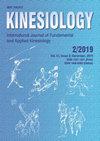国际项目10公里公开水域游泳的配速策略分析
IF 0.9
4区 医学
Q4 REHABILITATION
引用次数: 6
摘要
本研究的目的是确定在10公里公开水域游泳项目中采用的配速策略,并确定在国际锦标赛中,哪一段时间对最终成绩最具决定性,作为性别和分类的函数。回顾分析了过去五年的六项国际比赛:奥运会、世锦赛和欧洲杯。这些数据与437名游泳运动员的比赛历史相对应(257名男性,180名女性)。对每一段(0-2.5公里、2.6-5.0公里、5.1-7.5公里和7.6 -10公里)和半段(0-5公里、5.1-10公里)进行了双向方差分析(性别[2个水平:男性、女性],分类[3个水平:1- 3、4 - 8、9及以下])。使用Bonferroni事后检验比较平均值,使用Pearson简单相关系数确定分裂与最终表现(总时间)之间的相关性。总的来说,奖牌得主和排名第四到第八名的游泳运动员采用了消极的节奏策略(比赛前半段比后半段慢),男女选手都是如此。然而,按比例计算,女性的第一部分跑得比男性快(0到2.5公里)。这些结果可以帮助教练告诉游泳运动员,第一组的速度应该尽可能慢,但要保证在头球组。因此,它们将主要使用有氧能量,为第二次决定性的分裂“保留”能量。本文章由计算机程序翻译,如有差异,请以英文原文为准。
Analysis of pacing strategies in 10 km open water swimming in international events
The purpose of this study was to ascertain the pacing strategies employed in 10 km open water swimming events, and to define which split time was most determinant for the final performance as a function of gender and classification in International Championships. Six international competitions over the last five years were analyzed retrospectively: Olympic Games, World Championships, and European Championships. The data corresponded to a total of 437 swimmers' competition histories (257 men, 180 women). A two-way analysis of variance (gender [2 levels: men, women], classification [3 levels: 1st to 3rd, 4th to 8th, 9th and below]) was performed for each split (0-2.5 km, 2.6-5.0 km, 5.1-7.5 km, and 7.6 to 10 km) and halves (0-5 km, 5.1-10 km). The Bonferroni post hoc test was used to compare means, and Pearson's simple correlation coefficient to determine correlations between the split and the final performance (total time). In general the medal winners and those swimmers classified from 4th to 8th place employed a negative pacing strategy (the first half of the race slower than the second), in both men and women. Women, however, in proportional terms have a faster first partial (0 to 2.5 km) than men. These results could help coaches to indicate to the swimmers that the first split of the event should be as slow as possible but guarantying to be in the heading group. Thus, they would be using the aerobic energy mainly, "reserving" energy for the second and decisive split.
求助全文
通过发布文献求助,成功后即可免费获取论文全文。
去求助
来源期刊

Kinesiology
REHABILITATION-SPORT SCIENCES
CiteScore
1.90
自引率
8.30%
发文量
16
审稿时长
>12 weeks
期刊介绍:
Kinesiology – International Journal of Fundamental and Applied Kinesiology (print ISSN 1331- 1441, online ISSN 1848-638X) publishes twice a year scientific papers and other written material from kinesiology (a scientific discipline which investigates art and science of human movement; in the meaning and scope close to the idiom “sport sciences”) and other adjacent human sciences focused on sport and exercise, primarily from anthropology (biological and cultural alike), medicine, sociology, psychology, natural sciences and mathematics applied to sport in its broadest sense, history, and others. Contributions of high scientific interest, including also results of theoretical analyses and their practical application in physical education, sport, physical recreation and kinesitherapy, are accepted for publication. The following sections define the scope of the journal: Sport and sports activities, Physical education, Recreation/leisure, Kinesiological anthropology, Training methods, Biology of sport and exercise, Sports medicine and physiology of sport, Biomechanics, History of sport and Book reviews with news.
 求助内容:
求助内容: 应助结果提醒方式:
应助结果提醒方式:


